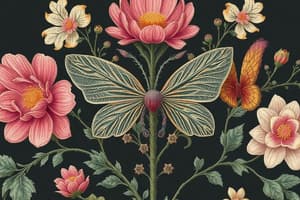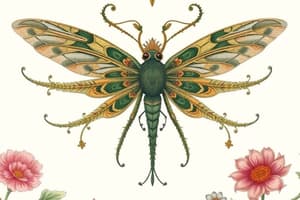Podcast
Questions and Answers
What characteristic is NOT common among reptiles?
What characteristic is NOT common among reptiles?
- Using a cloaca for excretion and reproduction
- Being warm-blooded (correct)
- Laying soft and leathery eggs
- Having scales made from keratin
Which group of animals is known for undergoing metamorphosis during their life stages?
Which group of animals is known for undergoing metamorphosis during their life stages?
- Arthropods
- Amphibians (correct)
- Fish
- Reptiles
Which of the following is NOT classified as an invertibrate?
Which of the following is NOT classified as an invertibrate?
- Tortoises (correct)
- Earthworms
- Crabs
- Octopuses
What is a common feature of amphibians concerning their offspring?
What is a common feature of amphibians concerning their offspring?
Which classification includes animals like snails and octopuses?
Which classification includes animals like snails and octopuses?
Who developed the binomial system of classification?
Who developed the binomial system of classification?
Which characteristic is NOT common to all mammals?
Which characteristic is NOT common to all mammals?
What is one of the defining features of the fish kingdom?
What is one of the defining features of the fish kingdom?
How many species of mammals are estimated to exist worldwide?
How many species of mammals are estimated to exist worldwide?
Which is NOT a characteristic of birds?
Which is NOT a characteristic of birds?
What major division exists within the animal kingdom that includes all mammals?
What major division exists within the animal kingdom that includes all mammals?
What do all members of the animal kingdom have in common?
What do all members of the animal kingdom have in common?
Which of the following is NOT a characteristic of fish?
Which of the following is NOT a characteristic of fish?
Flashcards
Reptiles
Reptiles
Animals like iguanas, tortoises and crocodiles that breathe air and are cold-blooded, meaning they can't regulate their body temperature.
Amphibians
Amphibians
Animals like frogs, toads and newts, adapted to live both on land and in water, lacking feathers, fur or scales.
Invertebrates
Invertebrates
Animals that lack a backbone, including insects, spiders, crabs, snails, octopuses, shellfish, parasitic worms, earthworms, and leeches.
Flowering Plants
Flowering Plants
Signup and view all the flashcards
Non-Flowering Plants
Non-Flowering Plants
Signup and view all the flashcards
Binomial System of Classification
Binomial System of Classification
Signup and view all the flashcards
Kingdom
Kingdom
Signup and view all the flashcards
Animal
Animal
Signup and view all the flashcards
Vertebrate
Vertebrate
Signup and view all the flashcards
Mammal
Mammal
Signup and view all the flashcards
Bird
Bird
Signup and view all the flashcards
Fish
Fish
Signup and view all the flashcards
Study Notes
Classification of Living Things
- Scientists classify living things based on shared characteristics.
- Carl Linnaeus developed the binomial system of classification in the 18th century. This system uses two Latin names to identify each species.
- For example, humans are Homo sapiens.
Kingdoms
- Organisms are classified into five kingdoms based on: cell structure (single or multicellular), how they obtain nutrients, and movement.
- Two notable kingdoms are Animalia and Plantae.
Animal Kingdom
- Contains approximately nine to ten million species.
- All members are multicellular and obtain nutrition by consuming other organisms.
- They can move using muscles or other means.
- Divided into invertebrates and vertebrates.
Vertebrates
- Mammals:
- Examples include cows, mice, and humans.
- Feed young with milk.
- Characteristics may include hair, live birth, regulating body temperature, and red blood cells without nuclei.
- About 5,500 species worldwide.
- Birds:
- Examples include sparrows, chickens, and ostriches.
- Have wings and feathers.
- Lay hard-shelled eggs.
- Adaptations may include flight, beaks suited for specific diets, and hollow bones.
- About 10,000 species worldwide.
- Fish:
- Examples include cod, sharks, and salmon.
- Live in water and have gills for breathing.
- Cold-blooded (cannot regulate temperature).
- Swim using tails and fins.
- Covered in scales.
- Lay many soft eggs outside the body.
- About 32,000 species worldwide.
- Reptiles:
- Examples include iguanas, tortoises, and crocodiles.
- Breathe air and are cold-blooded.
- Lay soft, leathery eggs.
- Covered in scales.
- Have a cloaca (single opening for excretion and reproduction).
- About 8,700 species worldwide.
- Amphibians:
- Examples include frogs, toads, and newts.
- Live both in water and on land.
- Moist, permeable skin allows gas exchange.
- Offspring develop in soft eggs, often laid in water.
- Undergo metamorphosis.
- About 8,100 species worldwide.
Invertebrates
- Animals without backbones.
- Examples include arthropods (insects, spiders, crabs), mollusks (snails, octopuses, shellfish), nematodes (parasitic worms), and annelids (earthworms, leeches).
Plant Kingdom
- Flowering Plants: This large group is further divided into monocots and dicots.
- Non-Flowering Plants: Includes plants not in the flowering plant classification.
Other Kingdoms (from the text)
- Fungi: A kingdom with its own set of characteristics
- Prokaryotes: Single-celled organisms without a nucleus.
- Protists: Diverse group of single-celled or simple multicellular organisms.
Studying That Suits You
Use AI to generate personalized quizzes and flashcards to suit your learning preferences.




